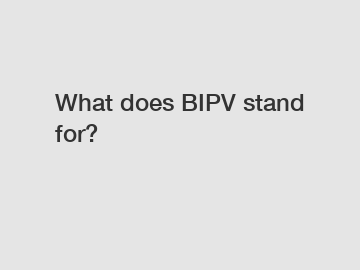Dec. 22, 2023
Energy
What does BIPV stand for? Exploring the Potential of Building Integrated Photovoltaics.
With the growing need for sustainable and renewable energy solutions, the world has turned its attention to exploring innovative methods of harnessing solar power. One such technology that has gained prominence in recent years is Building Integrated Photovoltaics, commonly known as BIPV. But, what does BIPV stand for, and how does it contribute to the future of clean energy? Let's delve into this exciting field and explore its potential.
1. Understanding BIPV: Building Integrated Photovoltaics (BIPV) refers to the integration of solar power-generating components into the building envelope itself. Unlike traditional photovoltaic installations, which are appended onto existing structures, BIPV seamlessly incorporates solar panels into building materials such as windows, roofs, facades, and even walls. This ingenious approach both enhances the aesthetics of buildings, integrating solar power generation into their inherent design, and maximizes the surface area available for capturing sunlight.

2. Advantages of BIPV: BIPV technology offers several advantages over conventional photovoltaic systems. Firstly, it eliminates the need for additional space, as the power-generating elements are seamlessly integrated into the building itself, making it an optimal choice for urban environments with limited rooftop space. Secondly, BIPV offers enhanced design possibilities, as solar panels can be manufactured in various colors, sizes, and shapes, allowing architects and designers to incorporate them harmoniously into the building's aesthetic appeal. Additionally, by generating clean electricity onsite, BIPV reduces transmission losses associated with long-distance energy transport.
Further reading:3. Applications of BIPV: BIPV holds immense potential across a wide range of applications. One prominent area where BIPV has seen notable success is in the residential sector. Solar windows and roofing tiles integrated with photovoltaic cells not only power homes but also offer a visually appealing alternative to traditional solar panels. BIPV has also found extensive use in commercial buildings, where glass curtain walls and transparent solar panels can generate electricity while providing shade and insulation. Furthermore, BIPV applications in infrastructure projects, such as noise barriers along highways and railways, also contribute to sustainable energy generation.
4. Market Growth and Future Prospects: BIPV technology has witnessed significant growth in recent years, and its market is projected to expand even further in the coming decade. The increasing global focus on sustainable construction, coupled with government incentives and regulations favoring renewable energy solutions, has propelled the adoption of BIPV technology. Moreover, advancements in thin-film solar cell technology have made it possible to integrate photovoltaic cells into flexible substrates, further expanding the potential applications of BIPV.
5. Overcoming Challenges: Despite its immense potential, BIPV faces a few challenges that need to be addressed. The first challenge lies in the cost-effectiveness of BIPV systems, as their integration into building materials can increase the upfront costs of construction. However, with advancements in manufacturing processes and economies of scale, the cost disparity between BIPV and traditional building materials is expected to decrease over time. Another challenge lies in the performance of BIPV systems, as the optimal orientation and shading of buildings can affect their efficiency. Therefore, careful planning and system design are essential for maximizing energy generation.
In conclusion, BIPV stands for Building Integrated Photovoltaics, a groundbreaking technology that integrates solar power-generating components into building materials, making it an integral part of the structure itself. BIPV offers numerous advantages, including space optimization, enhanced design possibilities, and reduced transmission losses. With applications ranging from residential buildings to infrastructure projects, BIPV has gained momentum in recent years and is expected to witness further growth in the future. Although challenges related to cost and system performance persist, continual advancements in technology are steadily addressing these concerns, making BIPV an increasingly viable and promising solution for clean energy generation.
Contact us to discuss your requirements of bipv advantages and disadvantages, Building-integrated photovoltaics supplier, integrated solar roof tiles. Our experienced sales team can help you identify the options that best suit your needs.
Further reading:Previous: Which diaphragm pump repair tip offers the best value?
Next: Which type of commercial inverter is best suited for your household energy needs?
Related Articles
If you are interested in sending in a Guest Blogger Submission,welcome to write for us!
All Comments ( 0 )